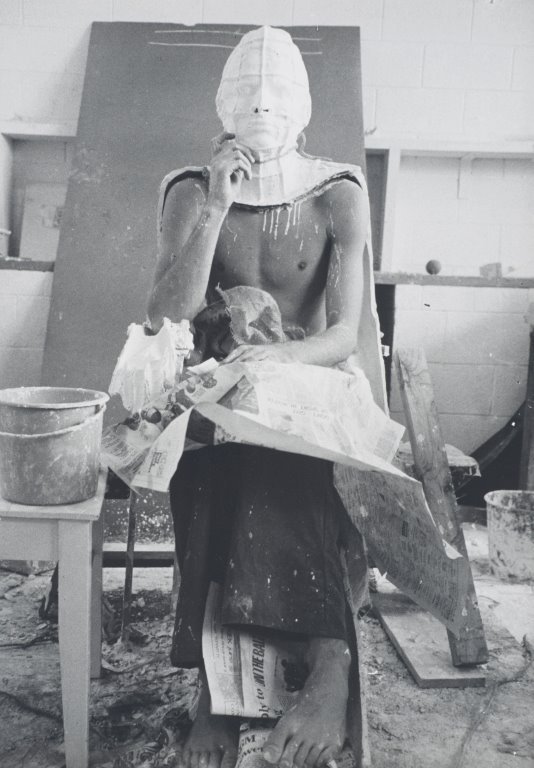Max Oettli: Visible Evidence
Max Oettli: Visible Evidence
Photographer Max Oettli reflects on a selection of his photographs with Ron Brownson, Senior Curator of New Zealand Art at Auckland Art Gallery Toi o Tāmaki.
Reprinted from Art Toi Magazine, November 2021
Max Oettli: Visible Evidence is showing at Auckland Art Gallery Toi o Tāmaki 18 Dec 2021 - 18 Sep 2022
Max Oettli, Self (3), 1972, gelatin silver print, Auckland Art Gallery Toi o Tamaki, gift of Max Oettli, through the Auckland Art Gallery Foundation, 2018
Ron Brownson: In 1975 I was living right next to Snaps, Tāmaki Makaurau Auckland’s first photographic gallery. Established by Glenn Busch and Alan Leatherby, Snaps’s inaugural exhibition profiled Swiss-born Max Oettli’s photographs. I worked as a gallery volunteer, which meant I could look closely at and spend extended time with Oettli’s black and white images. They proved an eye-opener to me: Oettli was committed to capturing inner-city street life with grit and humour while using the opposing light perspectives of night and day.
A number of the rare vintage photographs presented at the 1975 Snaps show are included in this selection, which the artist and I have written short comments on. These join more than 50 other photographs in the Gallery’s exhibition, Max Oettli: Visible Evidence – a strong representation of his practice during the 10-year period which also includes work from the 2018 gift Oettli made to the Gallery of his Auckland photographs.
The decade Oettli was active in Auckland coincided with the time when photography began to enter our art scene. The use of miniature 35mm cameras was widespread, providing photographers with technical versatility to match the varieties of imported film and stocks of photographic paper that were becoming available. Even in 1975, photography exhibitions were infrequently encountered in local galleries, but this did not discourage Oettli. An innovative artist, his vocation was independent of the marketplace – he chose when, what and where he photographed, working outside commercial constraints. Being spontaneous and intuitive, he approached his subject matter like a visual diarist, adroitly using a candid ‘shoot-from-the-hip’ technique influenced by French humanist photographer Henri Cartier-Bresson.
Unlike local camera club artists, Oettli avoided the tradition of ‘fine art’ exhibition prints, relishing instead the contrast of dark versus light. His images vary spatial depth, experiment with light and do not favour balanced exposures or pre-determined compositions. This imaginative confidence gives his photographs emotional vitality and expressive momentum.
Immediacy, rapid response and quirkiness are central to Oettli’s photographic practice. His images oppose notions of following a preconceived or correct photographic mode, and by concentrating on graphic intensity rather than conventional pictorial finesse, Oettli has helped redefine the relevance of street photography. Using his camera not merely as a functional extension of his curious eye, but instead an apparatus reflecting a discerning mindfulness, Oettli captures reality in a spontaneous, unrehearsed and intuitive way.
As a fellow immigrant from continental Europe, Oettli’s photographs share affinities with the work of Marti Friedlander and Ans Westra. Like them, he observes this country from a forward-looking urban perspective with a photographic agenda to seek out how people in New Zealand live. Oettli was also close to other New Zealand camera artists, including John Fields, John B Turner, Tom Hutchins and Laurence Shustak, who worked as professional photographers while maintaining their own personal artistic vocation.
Over the course of a decade Oettli emerged as one of New Zealand’s ground-breaking photographers. Dedicating himself to independent picture making – and avoiding editorial direction – the distinctive images he has created offer a live, subjective view of a time of immense change when New Zealand was opening up to the world and engaging in the cultural, political and social exchanges that would set the course on which we now find ourselves.
Max Oettli, Casting Rodney Fumpston 6, 1970, gelatin silver print, Auckland Art Gallery Toi o Tamaki, gift of Max Oettli, through the Auckland Art Gallery Foundation, 2018
Max Oettli: The plaster casting sequence happened quite early in my Elam career. I entered Elam School of Fine Arts in the current of 1970 and spent the first few months getting to know the staff and students and developing some notion of what I was supposed to be doing. John Haydn, whose project the casting was, had quite recently come back from a stay in California and was very excited by the People’s Park protest and its brutal culmination, which he had energetically photographed. We became good friends. Apart from the rich visual contents of the whole casting series (even the fact that I was shooting maybe 20 or 30 frames on one subject over a few days was unusual), it also fitted into my agenda as being strange and beautiful, scary even.
Max Oettli, Zack and the Lady, Kiwi Hotel, 1970, gelatin silver print, Auckland Art Gallery Toi o Tamaki, gift of Max Oettli, through the Auckland Art Gallery Foundation, 2018
RB: The Kiwi Hotel, on the corner of Symonds and Wellesley Streets, was renowned as the place where students and university staff gathered six days a week. On Monday 7 October 1967, when the enforced six o’clock closure of all hotel bars was lifted, the Kiwi opened from 11am to 10pm. Its business tripled overnight and it immediately became a centre of Auckland’s youth culture. However, the pub retained its regular clients, people who came for a drink almost every day. These friends are enjoying refreshments from glasses that were called ‘ponies’.
Read the full article on the Auckland Art Gallery website
We need your help to continue providing a year-round programme of online reviews, interviews, portfolios, videos and listings that is free for everyone to access. We’d also like to dream bigger with the services we offer to photographers and the visual arts.
We’ve partnered with Press Patron to give readers the opportunity to support PhotoForum Online.
Every donation helps.



